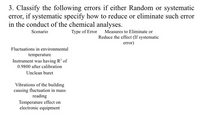
Chemistry
10th Edition
ISBN: 9781305957404
Author: Steven S. Zumdahl, Susan A. Zumdahl, Donald J. DeCoste
Publisher: Cengage Learning
expand_more
expand_more
format_list_bulleted
Question

Transcribed Image Text:3. Classify the following errors if either Random or systematic
error, if systematic specify how to reduce or eliminate such error
in the conduct of the chemical analyses.
Scenario
Type of Error Measures to Eliminate or
Reduce the effect (If systematic
error)
Fluctuations in environmental
temperature
Instrument was having R' of
0.9800 after calibration
Unclean buret
Vibrations of the building
causing fluctuation in mass
reading
Temperature effect on
electronic equipment
Expert Solution
This question has been solved!
Explore an expertly crafted, step-by-step solution for a thorough understanding of key concepts.
This is a popular solution
Trending nowThis is a popular solution!
Step by stepSolved in 2 steps

Knowledge Booster
Similar questions
- Data Set 1 Mass of Mg metal: 0.0462g Temperature of the water in the beaker: 22.0°C Total Volume of Gas Collected: 44.1 mL Barometric Pressure: 753 torr. Height of water column in Eudiometer: 0.0 mm Data Set 2 Mass of Mg metal: 0.0441 g Temperature of the water in the beaker: 22..6°C Total Volume of Gas Collected: 43.6 mL Barometric Pressure: 753 torr. Height of water column in the eudiometer: 19.0 mmarrow_forwardMake sure corrarrow_forwardTwo students perform the analysis of an alloy containing aluminum and zinc by the same method that we used in Experiment 2. They obtained the following data 0.007 g Mass of empty gelatin capsule Mass of gelatin capsule plus alloy sample 0.336 g 141.209 g Mass of empty beaker Mass of beaker plus displaced water 307.712 g 20 °C Temperature of water (and reaction mixture) Barometric pressure Density of water at 20°C 29.32 in. Hg 0.09982 g/mL 17.5 mm Hg Vapor pressure of water at 20°C What is n ? H₂ -2 a. 3.103 x 10 b. 6.336 x 10 c. 4.442 x 10 d. 3.030 x 10 e. 1.089 x 10 -1 -2arrow_forward
- If your numbers are precise but inaccurate, does it mean it might have been instrumental error? For my lab, I got an average of 8% error, all numbers close to each other. A question asks which was the possible major source of error. Since the numbers are precise but inaccurate, would this mean it is more likely an instrumental error? One of the scales only read two sig figs, which would make it more inaccurate overall. it was for ideal gas. %rsd: 5.08 std: 0.0043arrow_forwardSpaceX recently launched their Falcon Heavy rocket (Feb. 6, 2018). It is based on their existing Falcon 9 rocket. The Falcon 9 rocket has a first stage which is a 40 m high by 3.7 m diameter cylinder. This cylinder contains the fuel used to propel the rocket which consists of RP-1 (rocket propellant-1, high grade kerosene), and liquid oxygen, O2 (`). RP-1 is a complex mixture of hydrocarbons but let’s approximate it with a chemical composition of C12H26. The densities of the fuel are ρ (RP − 1) = 0.83 g cm3 ρ (liquid O2) = 1.141 g cm3 If the total volume available for the two tanks is contained in the 40 m high by 3.7 m diameter first stage, determine the volume of each individual tank that will provide the exact amount of RP-1 and oxygen for the reation (no limiting reagent) and take up the entire volume of the first stage. Here are some suggestions to guide you. 1. Write a balanced combustion reaction for C12H26 with O2. 2. Determine the ratio of the volumes of the individual RP-1…arrow_forwardGiven that the collision diameter of helium is 2.15 Å, calculate the mean free path of helium at sea level (1.00 atm and 25°C) and in the stratosphere (4.00x10-3 atm and -24°C). at sea level 4.0 1.98e-7 m in the stratosphere 4.0 2.15e-10 X m Supporting Materialsarrow_forward
arrow_back_ios
arrow_forward_ios
Recommended textbooks for you
 ChemistryChemistryISBN:9781305957404Author:Steven S. Zumdahl, Susan A. Zumdahl, Donald J. DeCostePublisher:Cengage Learning
ChemistryChemistryISBN:9781305957404Author:Steven S. Zumdahl, Susan A. Zumdahl, Donald J. DeCostePublisher:Cengage Learning ChemistryChemistryISBN:9781259911156Author:Raymond Chang Dr., Jason Overby ProfessorPublisher:McGraw-Hill Education
ChemistryChemistryISBN:9781259911156Author:Raymond Chang Dr., Jason Overby ProfessorPublisher:McGraw-Hill Education Principles of Instrumental AnalysisChemistryISBN:9781305577213Author:Douglas A. Skoog, F. James Holler, Stanley R. CrouchPublisher:Cengage Learning
Principles of Instrumental AnalysisChemistryISBN:9781305577213Author:Douglas A. Skoog, F. James Holler, Stanley R. CrouchPublisher:Cengage Learning Organic ChemistryChemistryISBN:9780078021558Author:Janice Gorzynski Smith Dr.Publisher:McGraw-Hill Education
Organic ChemistryChemistryISBN:9780078021558Author:Janice Gorzynski Smith Dr.Publisher:McGraw-Hill Education Chemistry: Principles and ReactionsChemistryISBN:9781305079373Author:William L. Masterton, Cecile N. HurleyPublisher:Cengage Learning
Chemistry: Principles and ReactionsChemistryISBN:9781305079373Author:William L. Masterton, Cecile N. HurleyPublisher:Cengage Learning Elementary Principles of Chemical Processes, Bind...ChemistryISBN:9781118431221Author:Richard M. Felder, Ronald W. Rousseau, Lisa G. BullardPublisher:WILEY
Elementary Principles of Chemical Processes, Bind...ChemistryISBN:9781118431221Author:Richard M. Felder, Ronald W. Rousseau, Lisa G. BullardPublisher:WILEY

Chemistry
Chemistry
ISBN:9781305957404
Author:Steven S. Zumdahl, Susan A. Zumdahl, Donald J. DeCoste
Publisher:Cengage Learning

Chemistry
Chemistry
ISBN:9781259911156
Author:Raymond Chang Dr., Jason Overby Professor
Publisher:McGraw-Hill Education

Principles of Instrumental Analysis
Chemistry
ISBN:9781305577213
Author:Douglas A. Skoog, F. James Holler, Stanley R. Crouch
Publisher:Cengage Learning

Organic Chemistry
Chemistry
ISBN:9780078021558
Author:Janice Gorzynski Smith Dr.
Publisher:McGraw-Hill Education

Chemistry: Principles and Reactions
Chemistry
ISBN:9781305079373
Author:William L. Masterton, Cecile N. Hurley
Publisher:Cengage Learning

Elementary Principles of Chemical Processes, Bind...
Chemistry
ISBN:9781118431221
Author:Richard M. Felder, Ronald W. Rousseau, Lisa G. Bullard
Publisher:WILEY